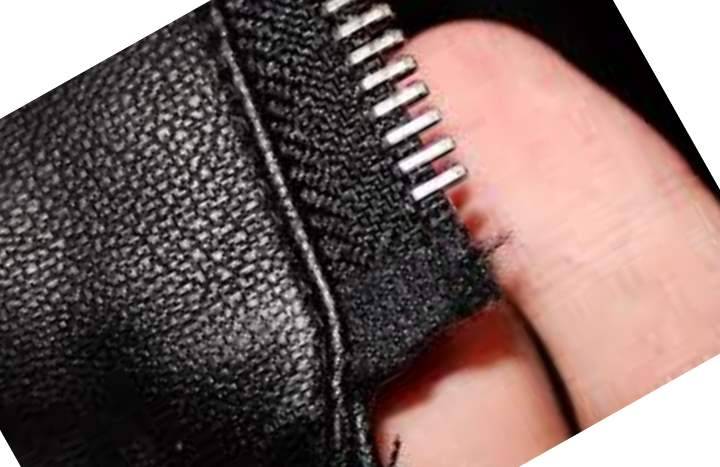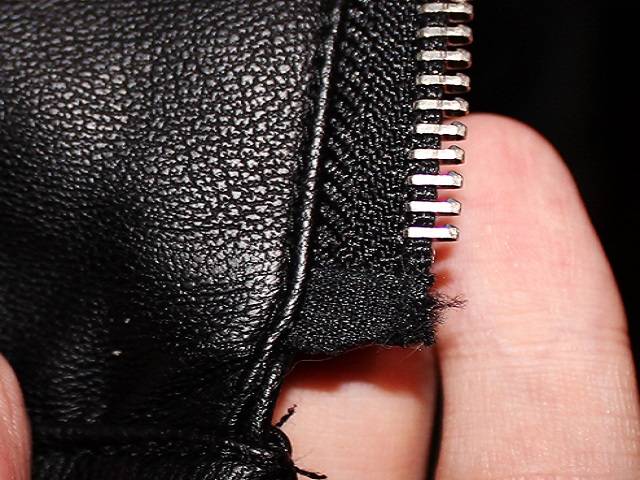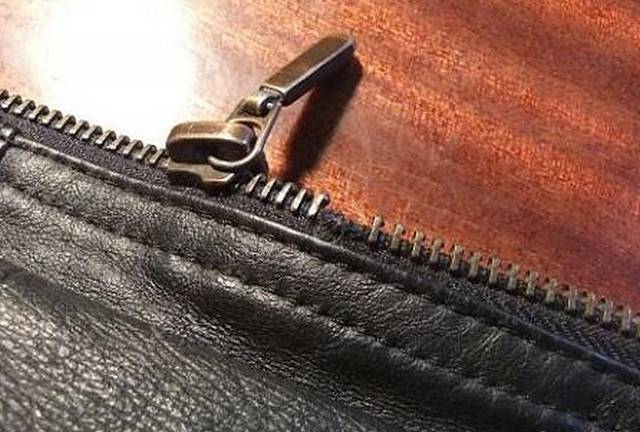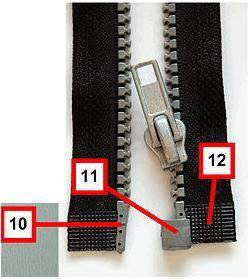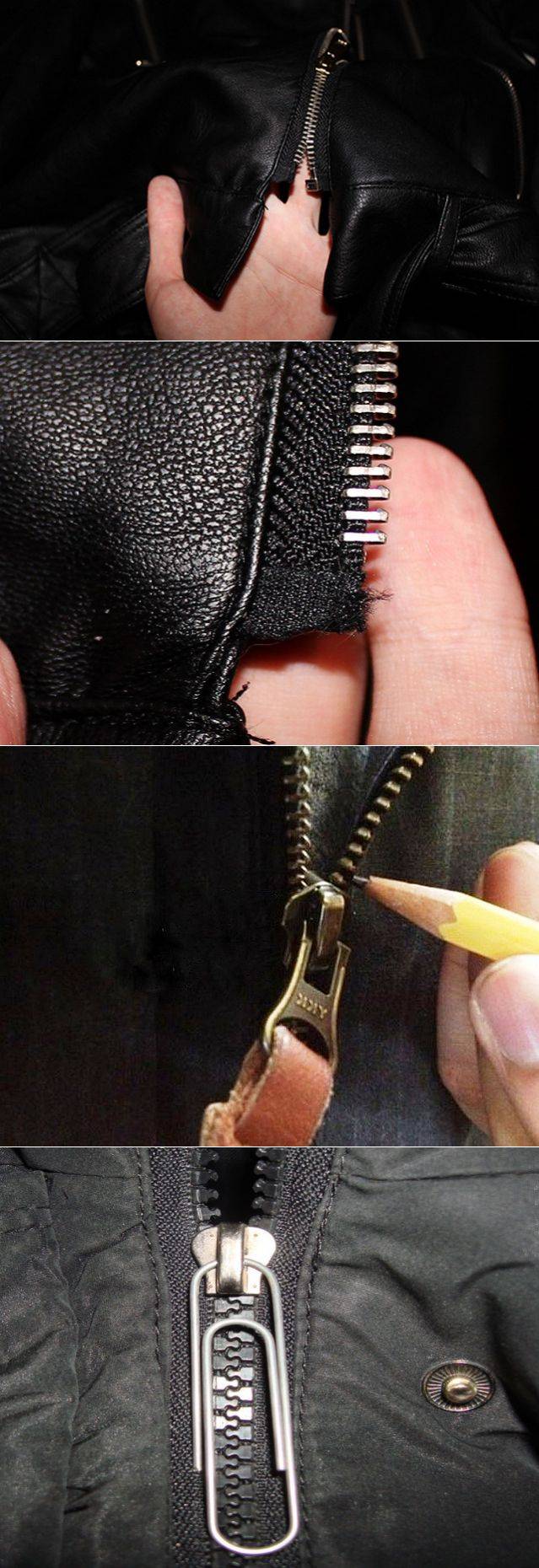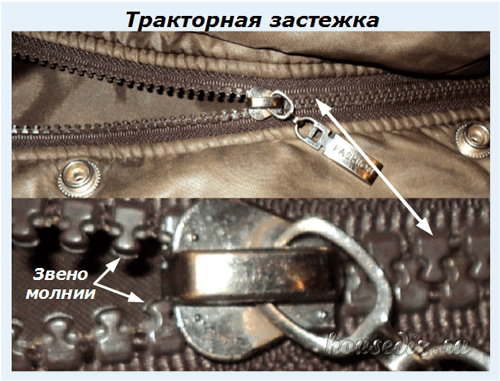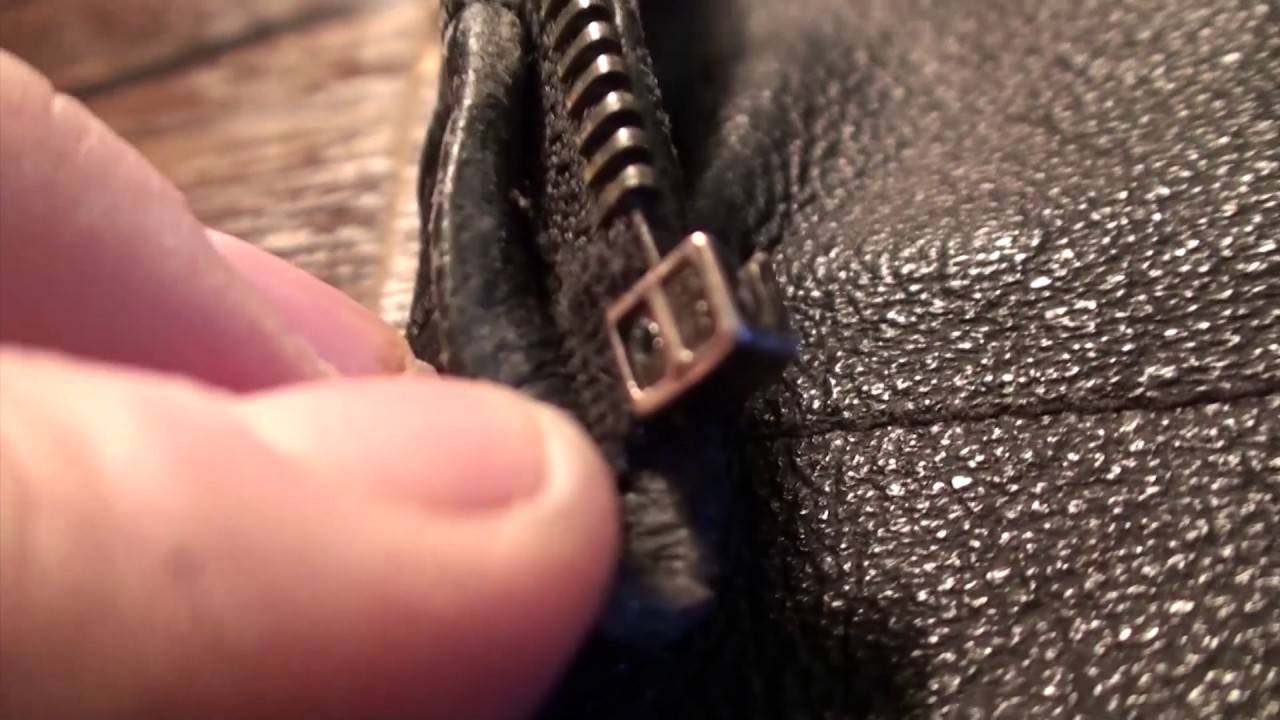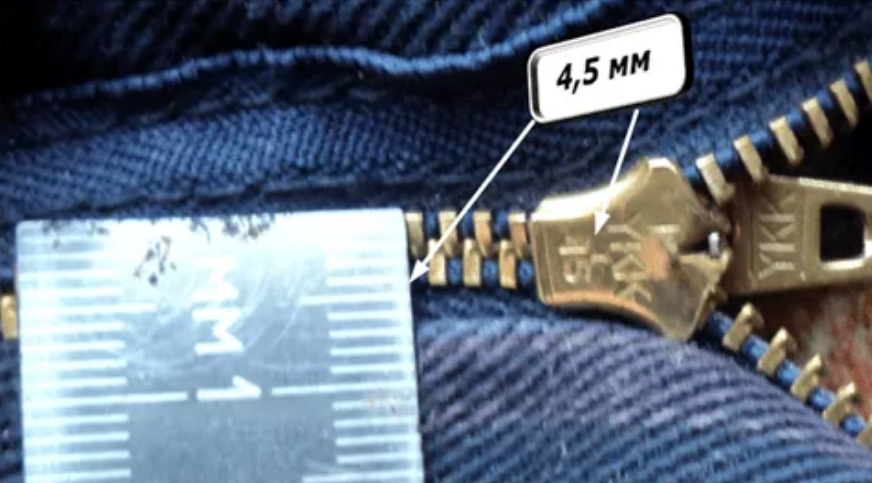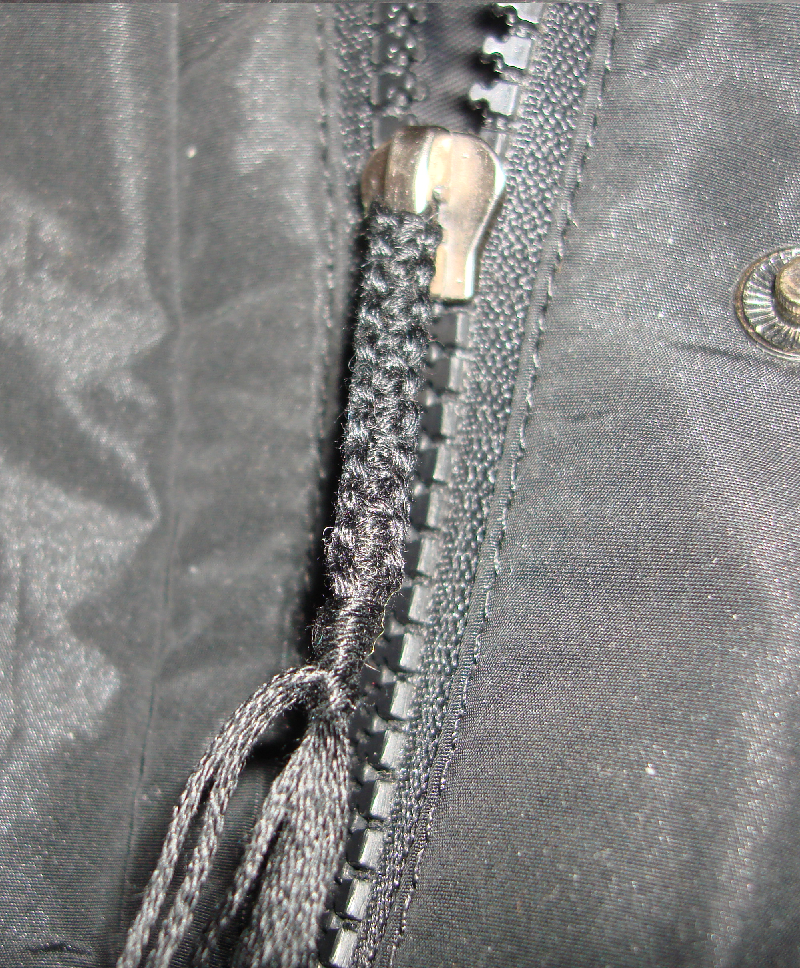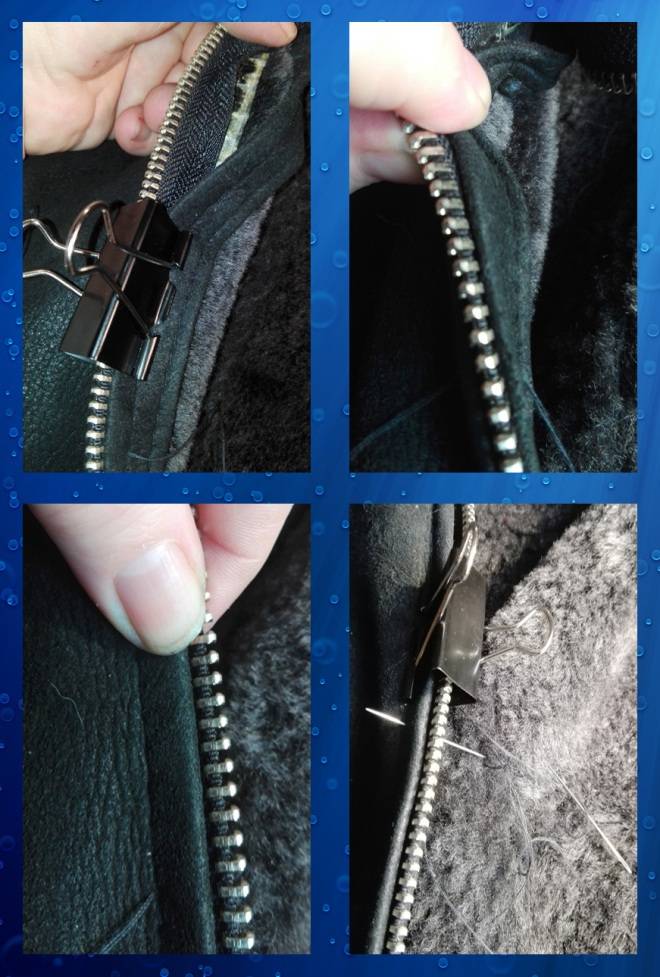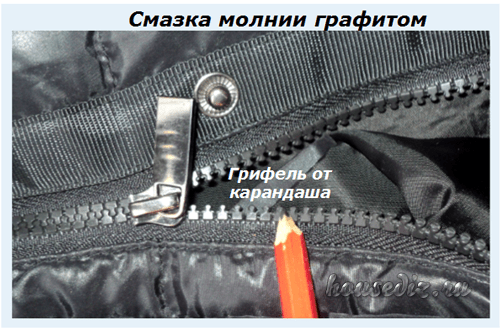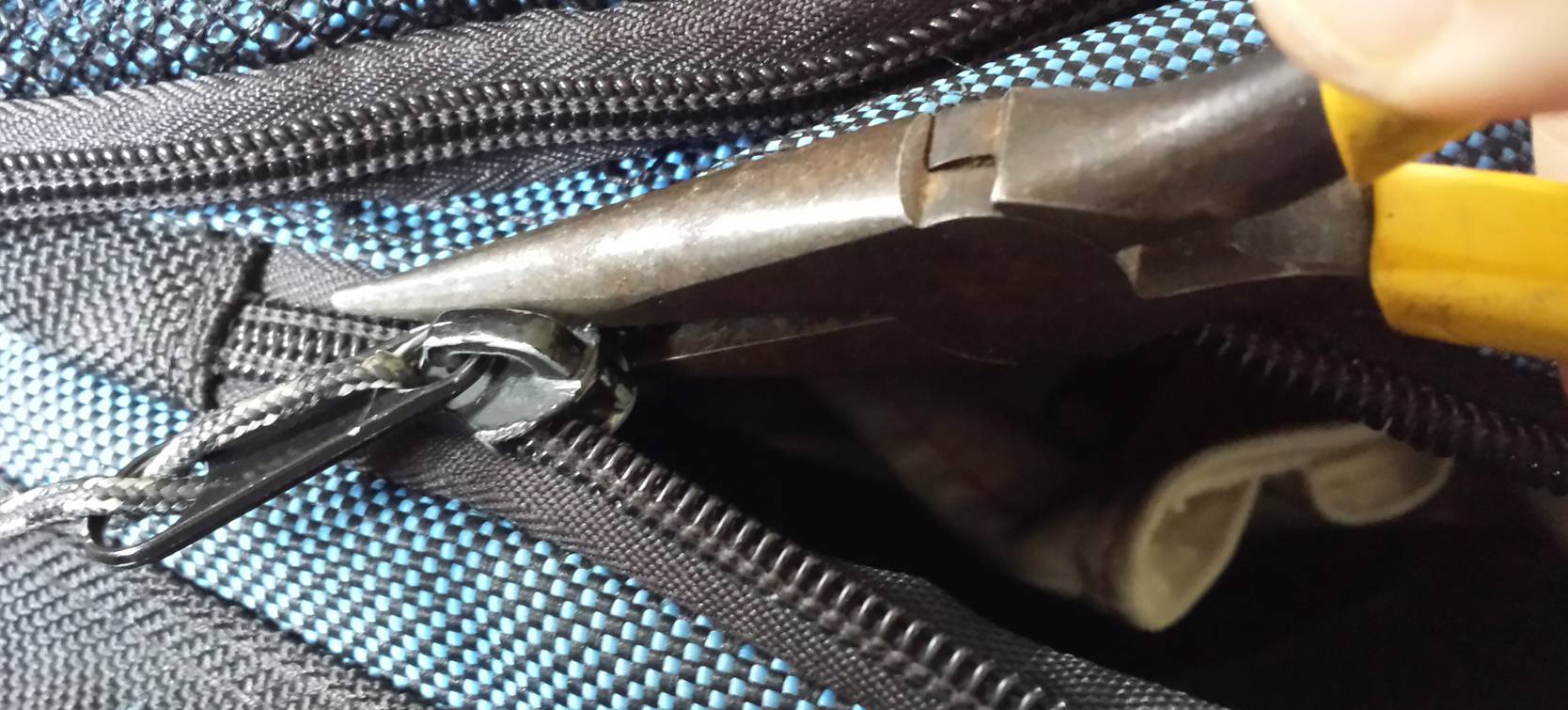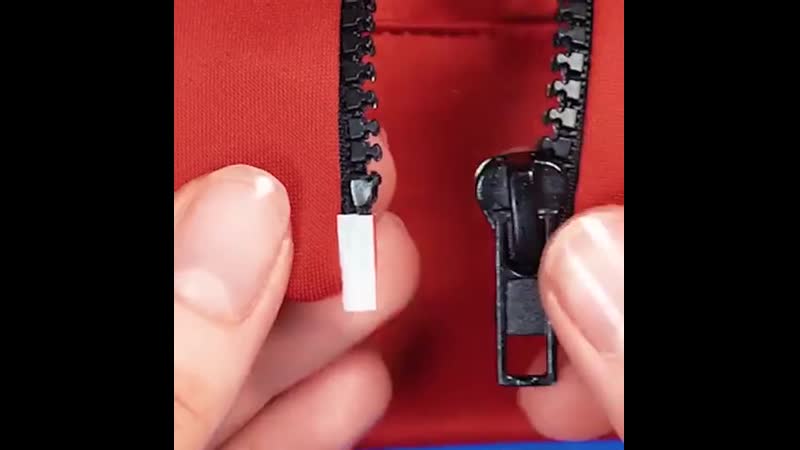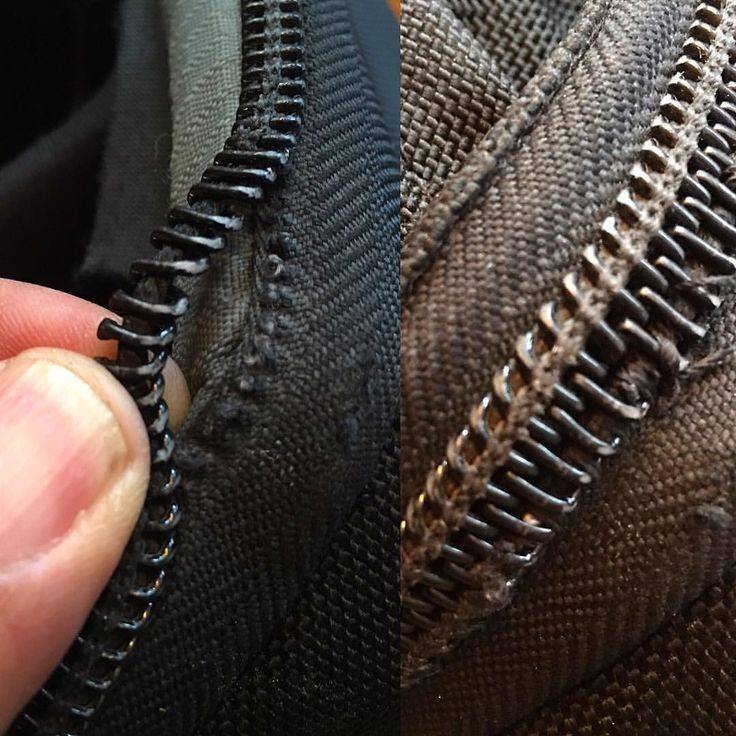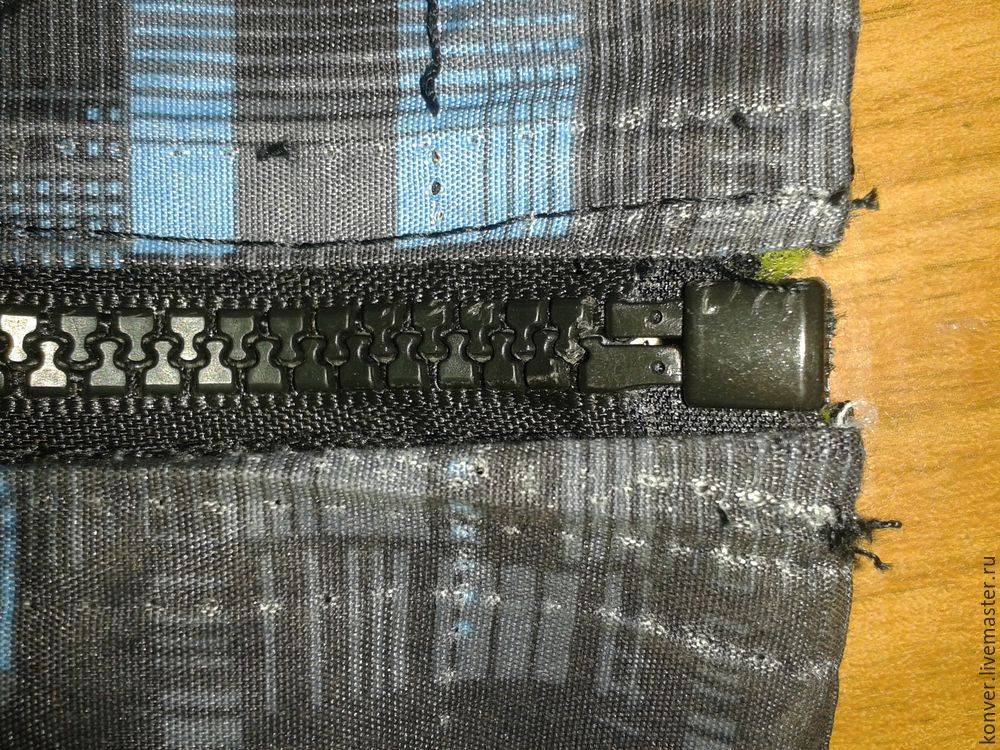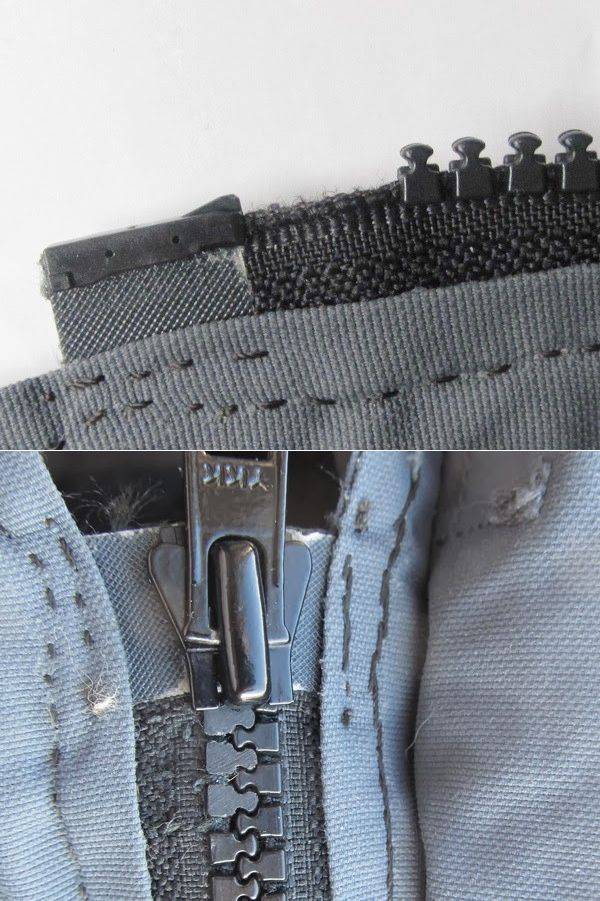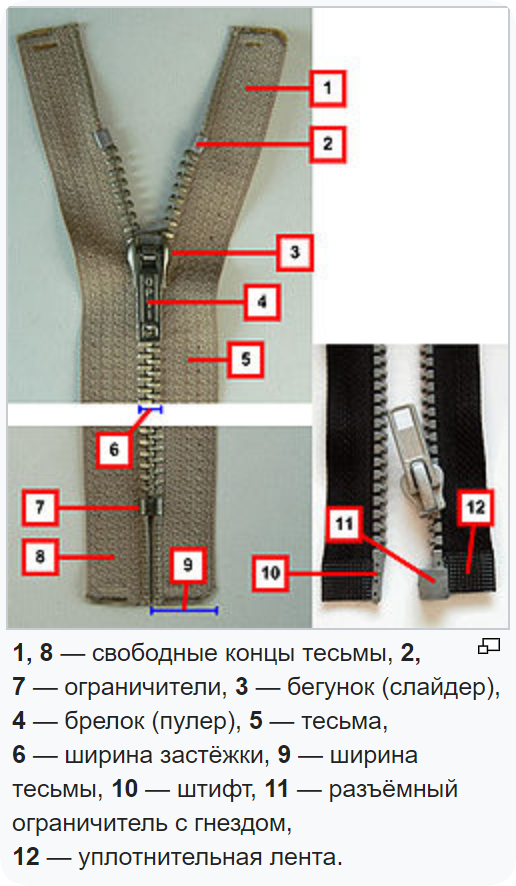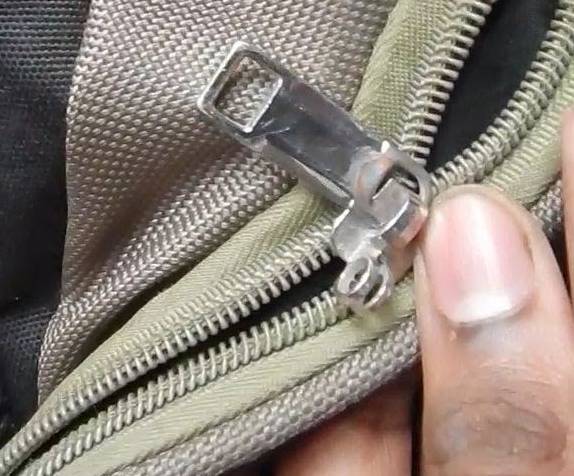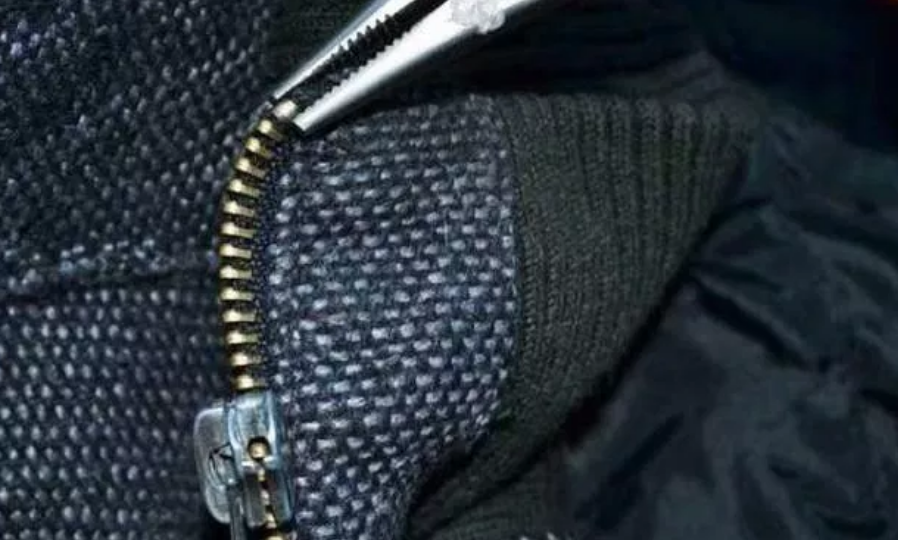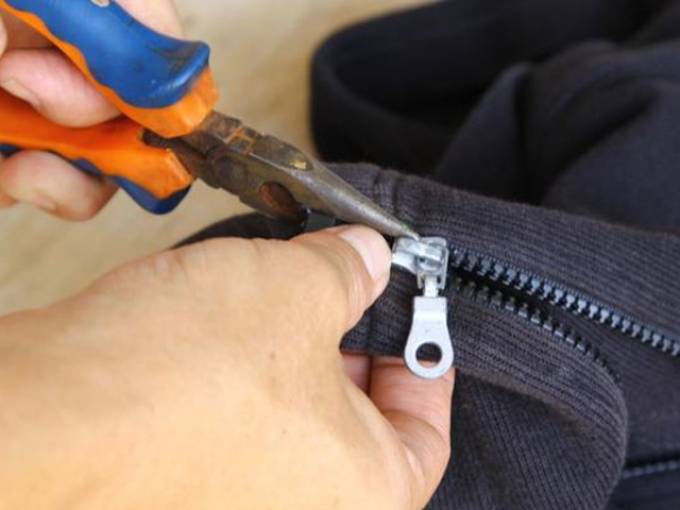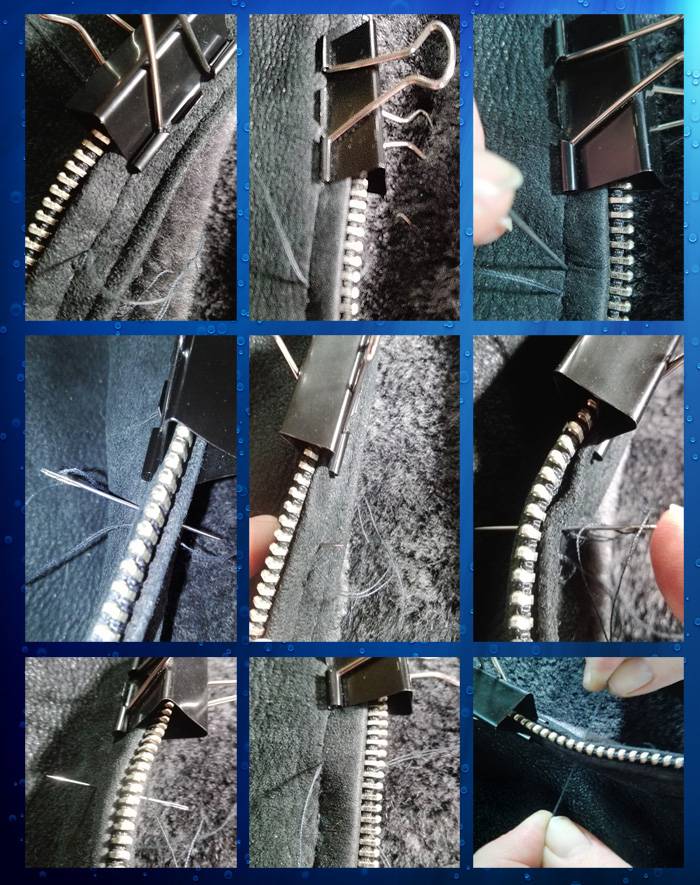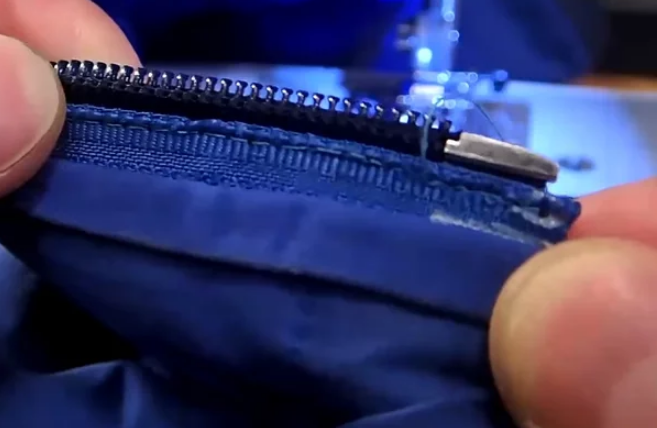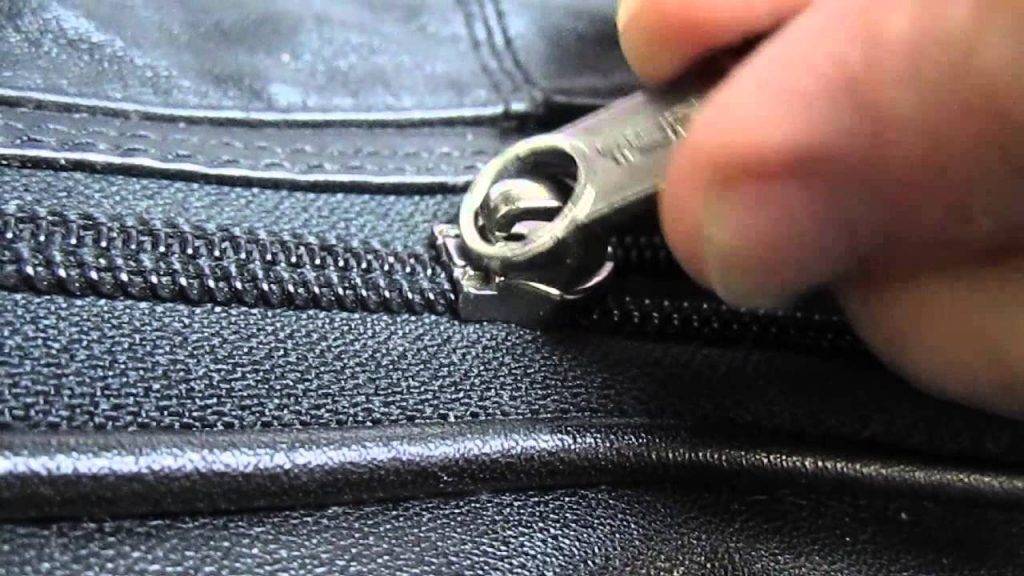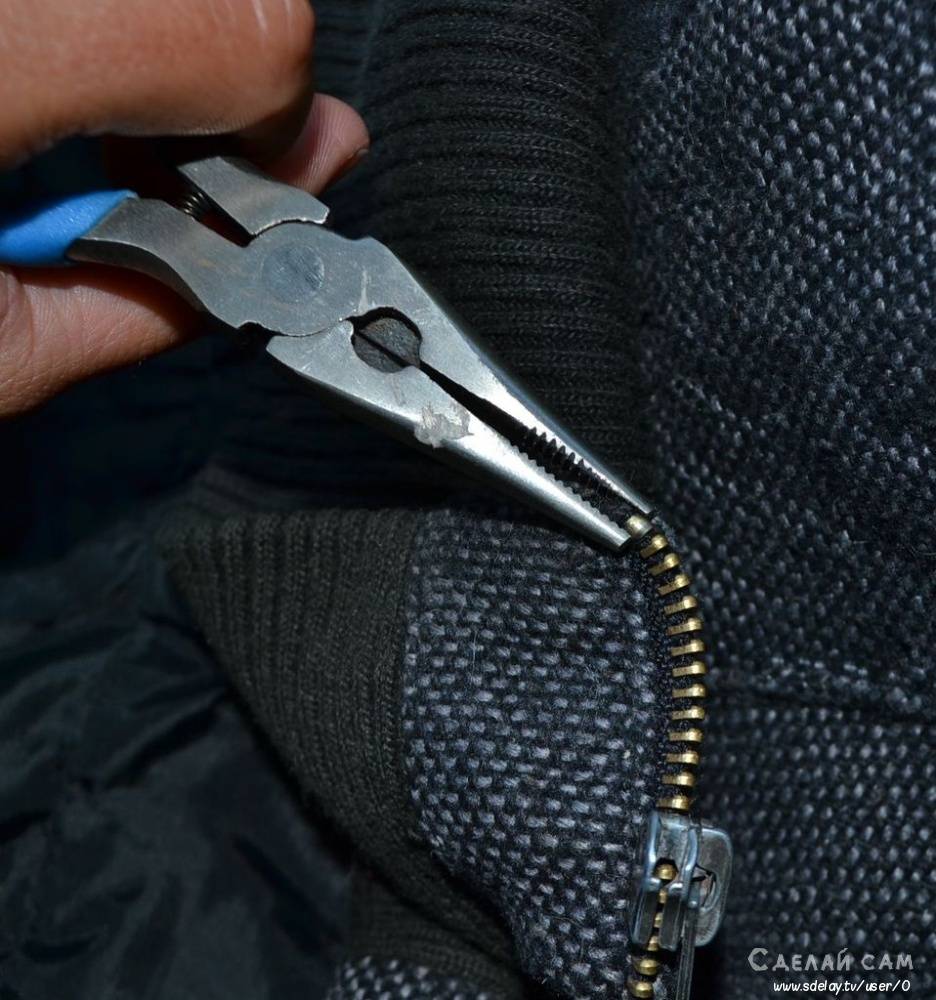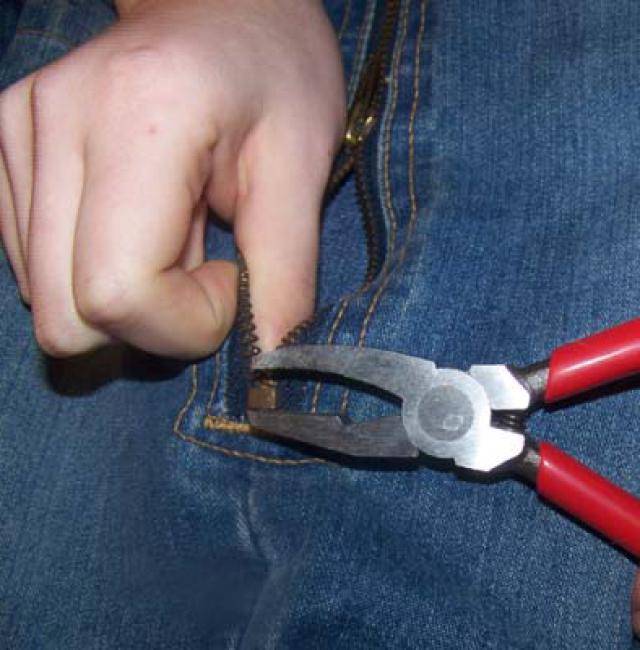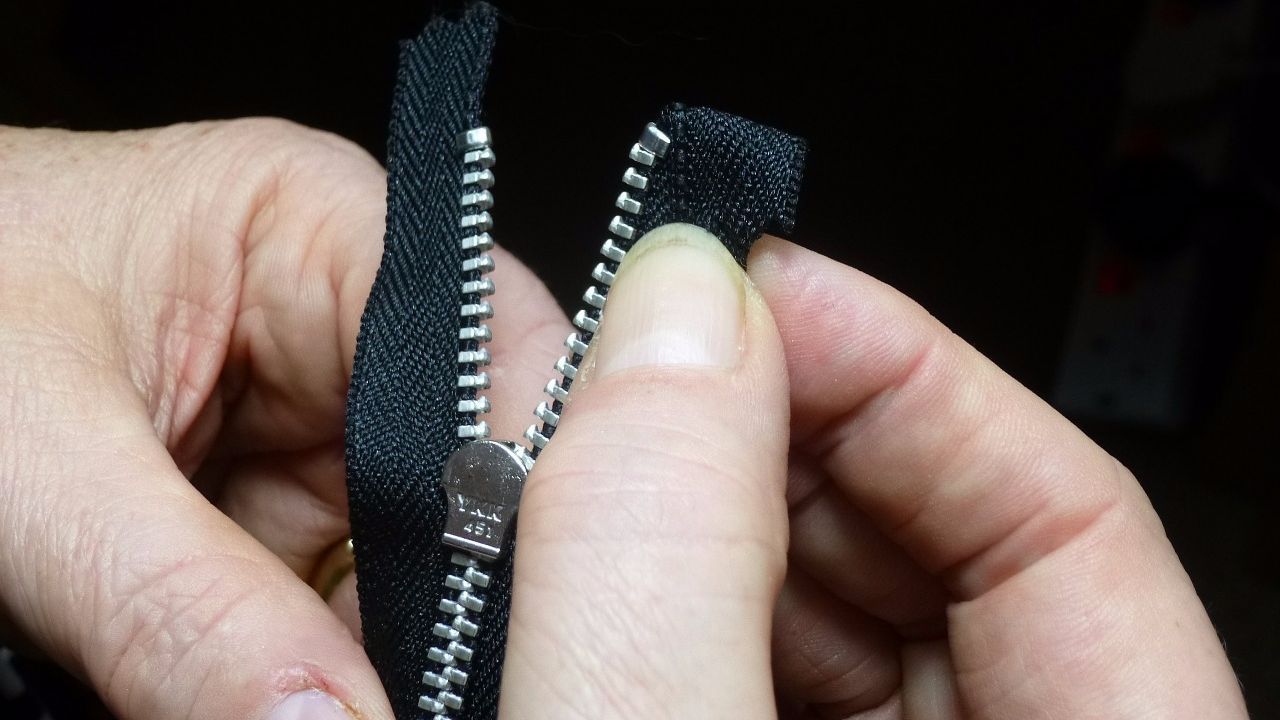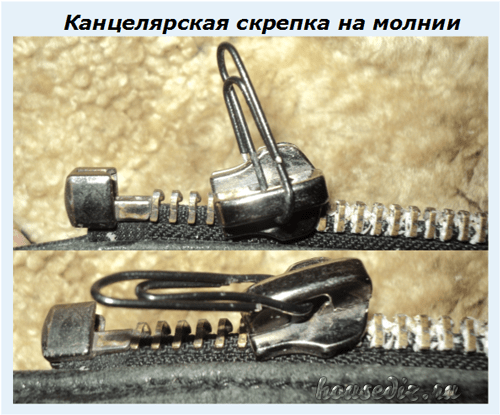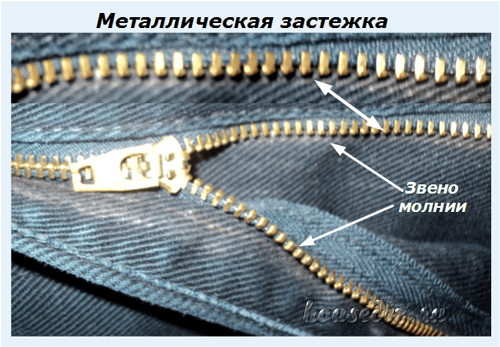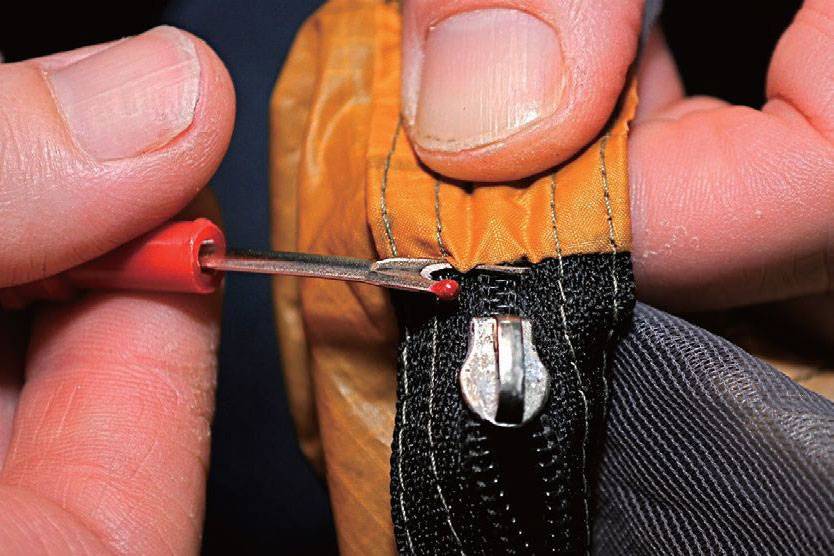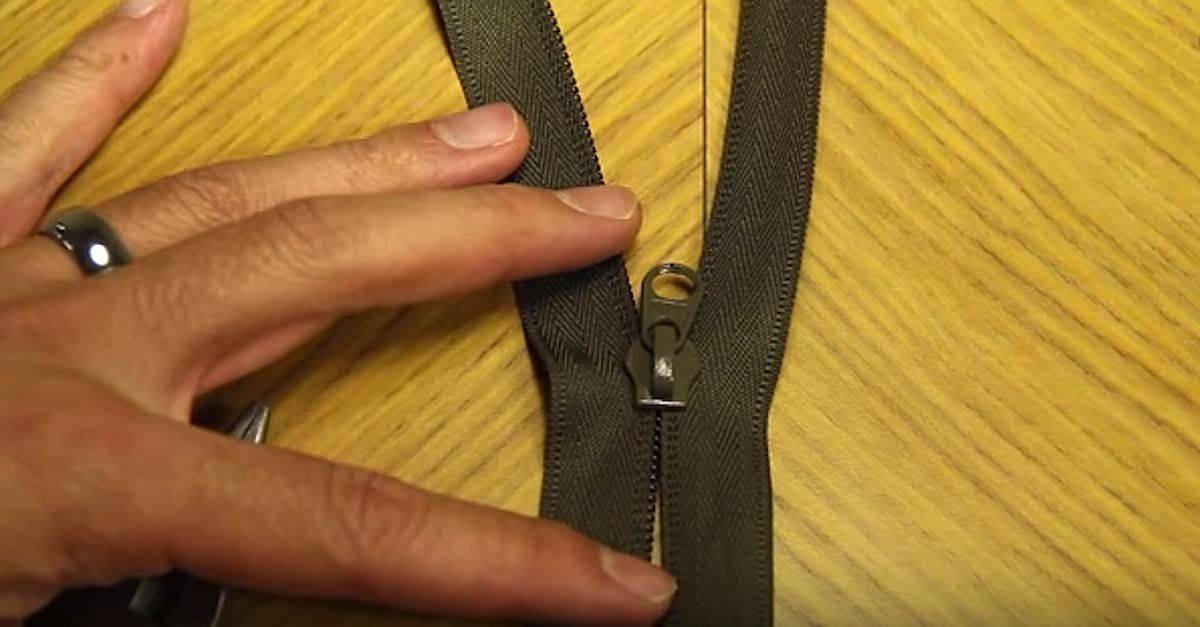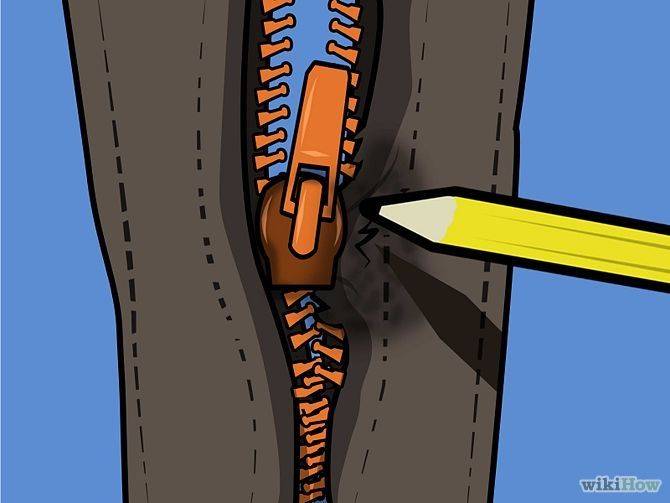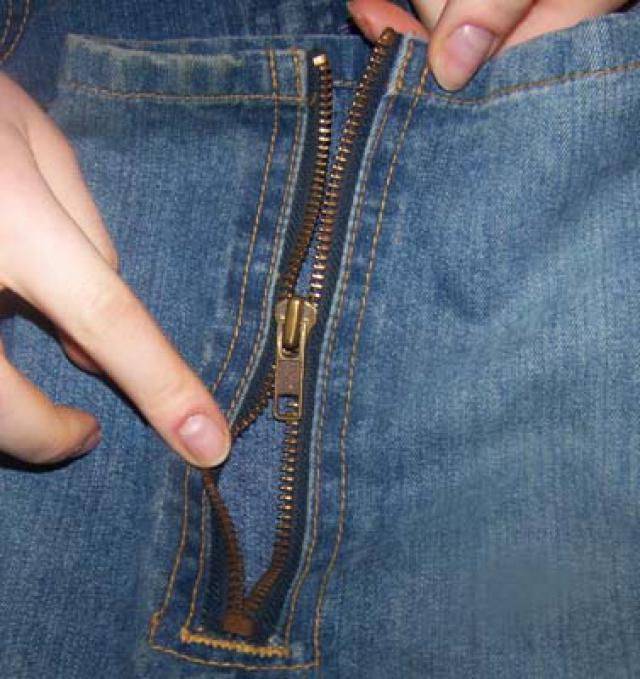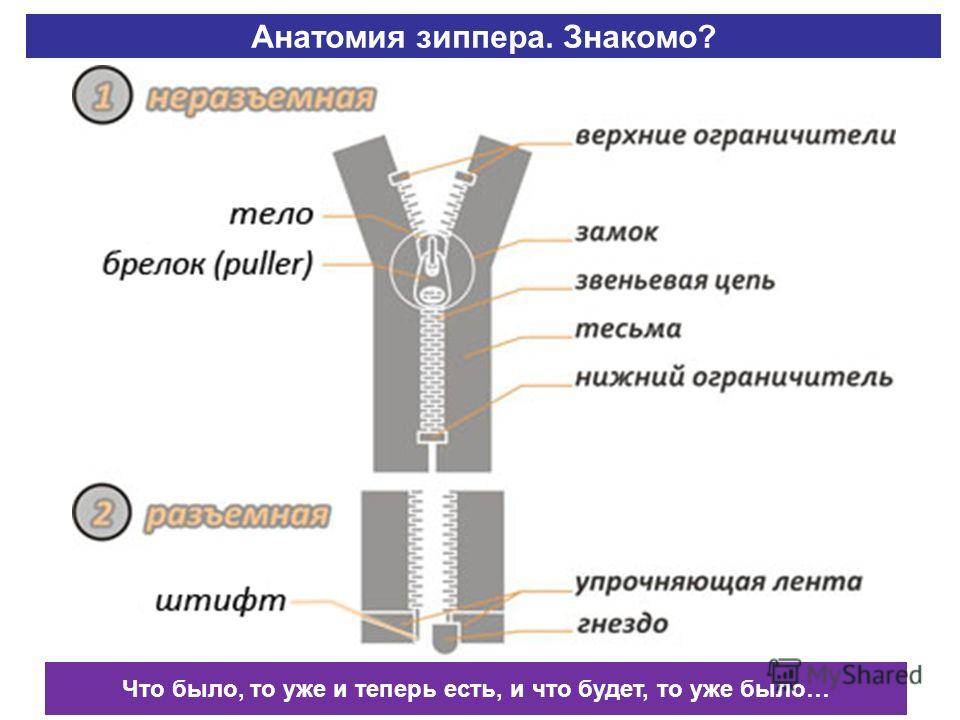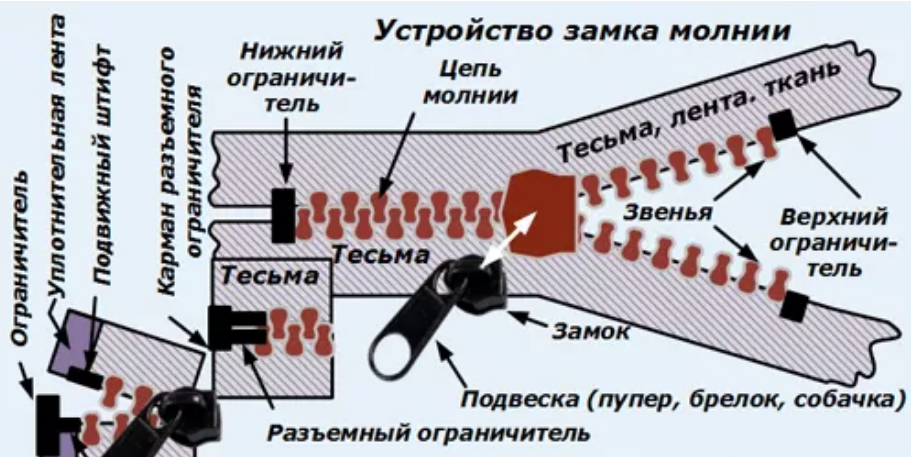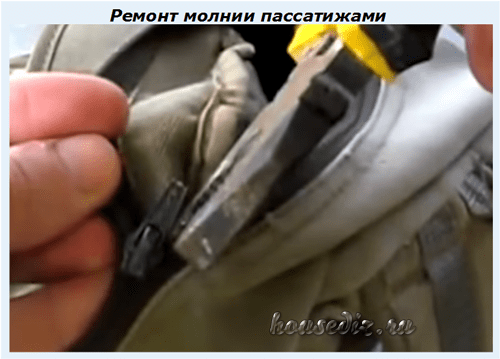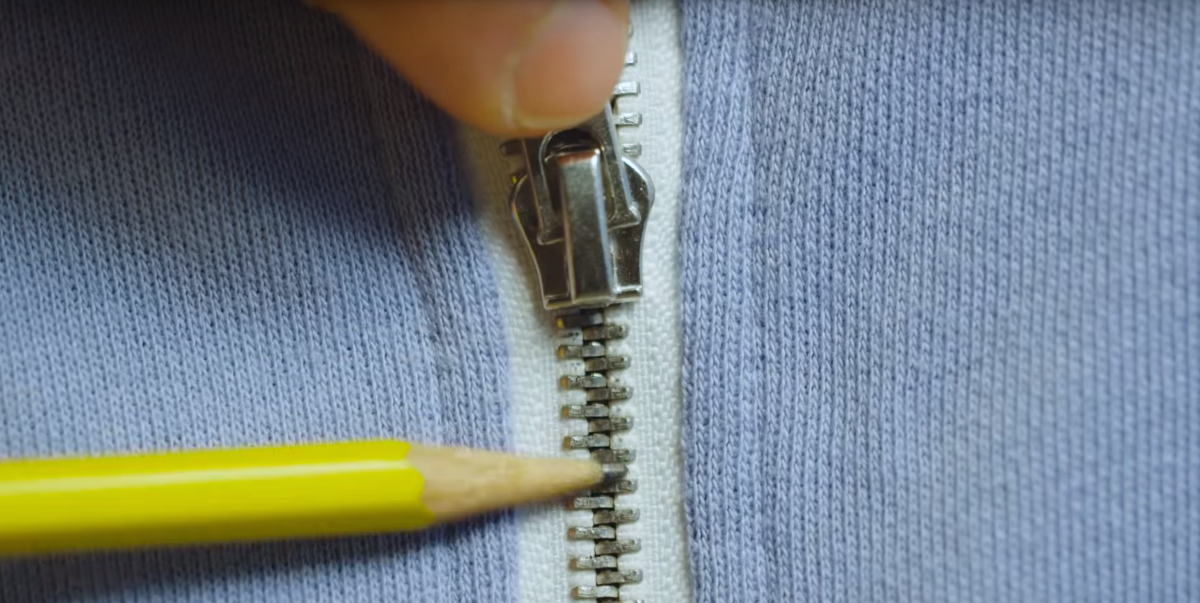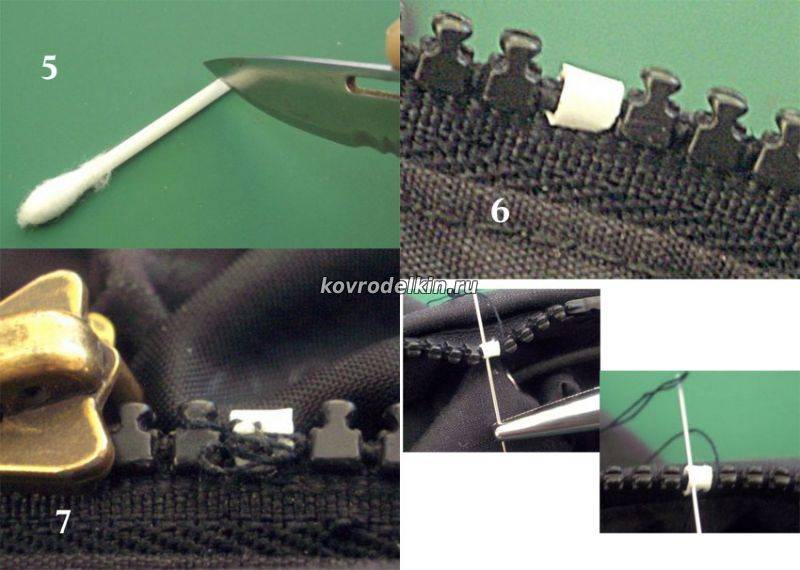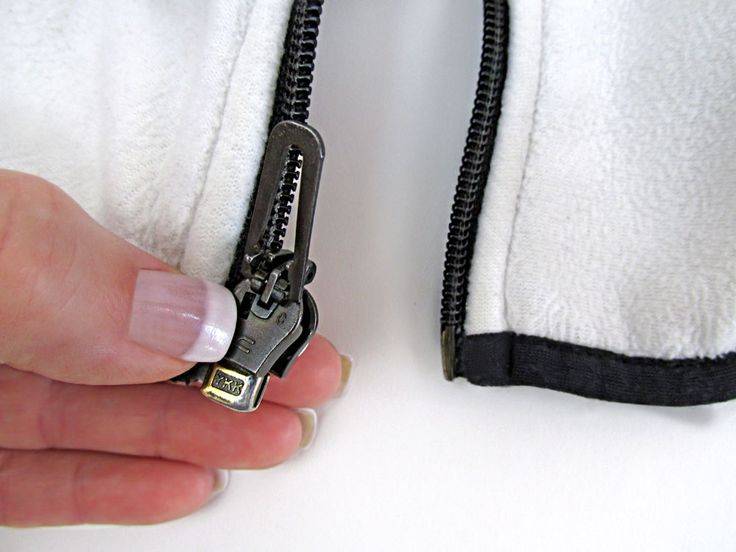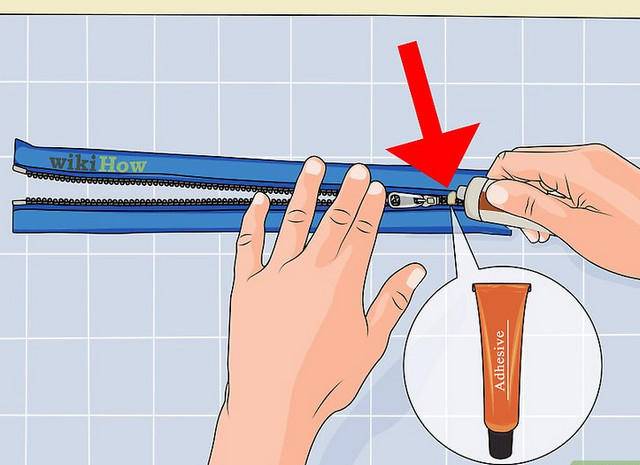How the lock works
Lightning works on the following principle:
- The latch is inserted into the zipper socket;
- The dog stretches up to the closure, reliably interlocking the teeth;
- If the pawl goes down to the opening, then it disengages the teeth of the lock.
- To prevent the zipper from diverging after closing, the dog's ear is slightly pressed down. They just fix it in a given position.
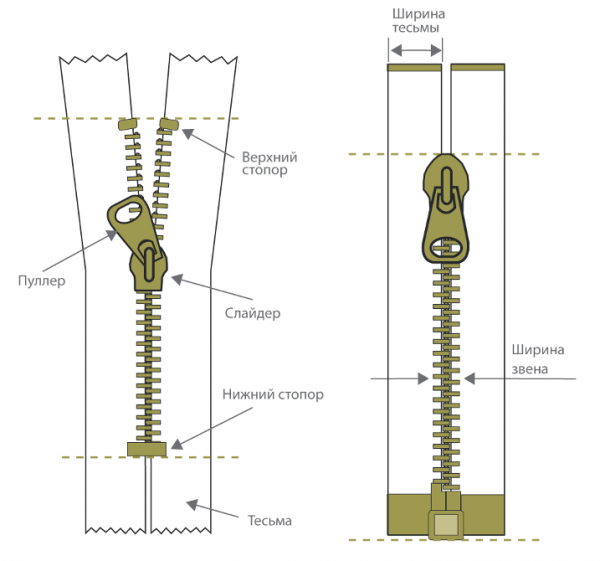
There are several types of locks:
- Machine. The pawl automatically fixes the position of the lock in the closed or open state. It lends itself only to the movement of the hand. Arbitrarily does not move up or down through the lightning. Inside such a dog there is a special retainer.
- Haberdashery type. Has no lock and lends itself to light pressure in the top closed position to prevent the zipper from opening.
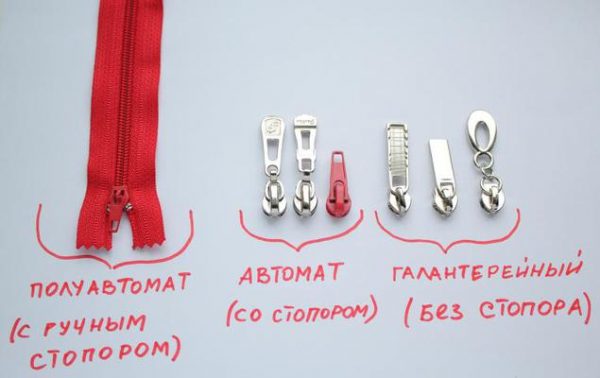
Problem 1 - a zipper opens a snake
One of the most common problems with lightning is that it starts to diverge. Not everyone knows that this difficulty, especially at first, is very easy to solve. After all, the reason that the lightning diverges is the slider (popularly this part of the zipper is often called the "dog"): it expanded from frequent use and stopped tightly pressing the snake's teeth to each other. How to deal with this problem?
Take a pair of pliers and firmly squeeze one side of the slider first and then the other. The main thing here is not to overdo it, otherwise the slider will stop moving altogether. Close the zipper. Usually, such a simple repair is enough for the lightning to start working properly.
Can the slider be rearranged?
In principle, it is possible, but this applies to things where it is not fundamentally important in which direction the lock opens (handbags, cosmetic bags, etc.)
Repair of the "snake" in this case is extremely simple. Move the slider to the opposite side, and sew the free ends together to prevent the slider from slipping.
If the "dog" has broken down completely, do not waste time fixing it and buy a new one in a sewing store. If you could not find the correct product, do the following:
- Unfold the stopper.
- Insert the slider.
- Rub the teeth of the lock with paraffin wax or a stearin candle.
Everything! You can use the lock.
Types
The types of zippers are determined by the functional features of the locks: presence, lack of protection against spontaneous unfastening.
Castles are:
- auto-lock, A / L - automatic;
- pin-lock, P / L - semi-automatic;
- non-lock, N / - haberdashery.
The use of locks depends on the type of fastener.
Auto
The A / L lock has a slider with a mechanism that interlocks the links and prevents them from diverging, regardless of the suspension position. The brakes are spring-loaded spikes located inside the runner. Disengagement occurs when pulling force is applied to the key fob. Automatic locks are used on split models with large teeth.
Semi-automatic
The P / L lock has a slider with spikes located in the key fob. When the tongue is lowered, the pins enter between the teeth and impede the movement of the dog. To open the zipper, you need to lift the puller. Semiautomatic devices are used in split types.
Haberdashery
Clasp with lock N / L: the slider does not have an automatic machine and a stopper, it moves without fastening. Such sliders are installed on permanent connections.
Damage prevention
To prevent damage from lightning, there are a few simple tips to follow:
- During the wash, all zippers should be fastened on the jacket and the garment should be turned inside out.
- When ironing clothes with a fastener made of non-heat-resistant materials, avoid hitting the iron in the zipper area.
- To prolong the life of the lock, it must be periodically treated with special care products such as a hydrophobic lubricant. This substance provides the fastener with a waterproof and windproof protection.
- Before pulling the slider from below, you need to insert both parts into the lock until they stop.
- It is sometimes necessary to treat the teeth and lock with a soft pencil lead or other substance to lubricate the surface.
- You need to fasten the zipper without haste and application of force, at this moment the tape should be in a taut position.
To prevent wear, periodically clean all parts of the zipper with a small brush. It is recommended to use a toothbrush, as its villi are quite soft and small. With a careful and careful attitude, any thing can serve for many years without a single repair.
 Fasten all zippers during washing, turn the garment inside out
Fasten all zippers during washing, turn the garment inside out When ironing, avoid hitting the iron in the zipper area
When ironing, avoid hitting the iron in the zipper area To prolong the life of the lock, periodically treat with a care product
To prolong the life of the lock, periodically treat with a care product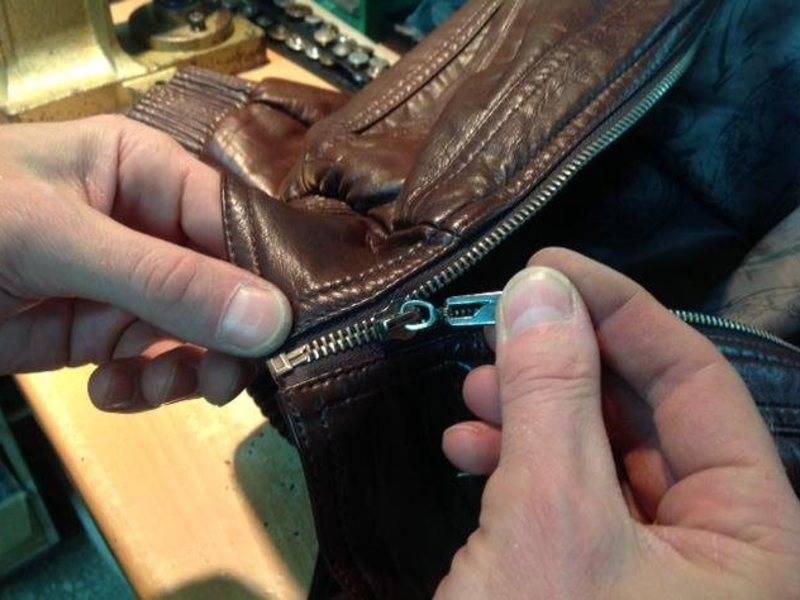 Insert both parts of the slider into the lock until it stops.
Insert both parts of the slider into the lock until it stops. Carry out the processing of teeth and lock
Carry out the processing of teeth and lock Fasten without haste and use of force
Fasten without haste and use of force
How the lock works
The zipper is popular for its simplicity and convenience. It is often found on clothing, shoes and bags.
Description of construction
The zipper consists of:
- two strips of fabric;
- lock (slider);
- rings;
- pendants (dog, keychain, duper);
- links;
- limiters;
- pins;
- a detachable limiter with a socket;
- sealing tape.
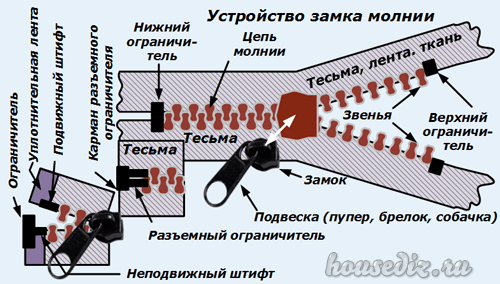
How the lock works
Two textile belts with attached zipper links and a stopper on each are assembled with a lock in a common engagement with teeth.
Closing work
If you pull on the dog with your fingers, the slider begins to slide along the links of the braid, connects the teeth in turn, fixes them together: the lock closes. The limiter determines the dog's range of motion.
Opening work
When the suspension lock moves back, the links are disengaged and the zipper is released.
What is the clasp
Manufacturers produce three link connection designs:
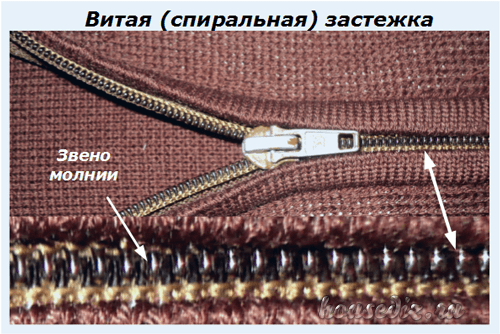
The most durable are metal zippers. Tractor fasteners are highly wear-resistant, while spiral fasteners have good elasticity.
Slider classification
Locks are made to match each link of the fastener with different ways of its work.
Each type of zipper uses a certain type of lock.
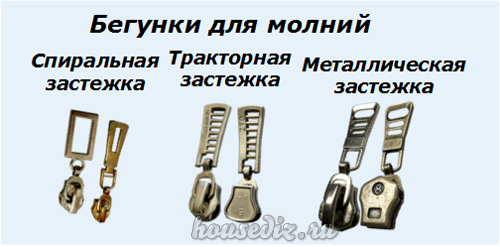
The number of the slider corresponds to the width of the links, measured in mm between the teeth when the zipper is closed. They are marked with a number on the back. The shape of the sole is determined from the seamy part of the lock.
Castle construction
By the way they work, the runners are divided into:
- an automatic machine, the mechanism of which does not allow the links to diverge regardless of the position of the dog;
- a semiautomatic device that allows unbuttoning only when the dog is in the raised position. The design includes a special lock;
- haberdashery: there is no stopper, and the links are not blocked. This allows the zipper to move freely without any fastening.
Why does the lock break
The most common cause of fastener breakage is wear of the inner cavities of the runner, when the mechanism cannot connect the links, and the zipper diverges.
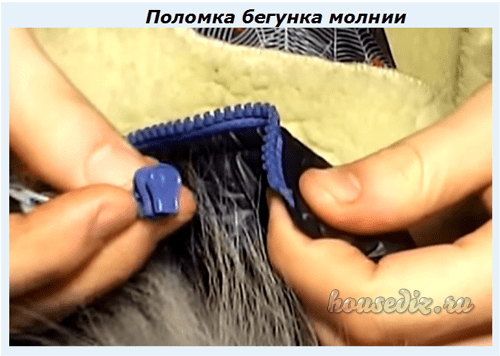
Dangers exposed to lightning on:
- shoes, as sand and dirt are clogged in them;
- jackets and outerwear, when they are fastened with jerks with brute force;
- as well as all plastic parts subject to sudden temperature changes.
The castle falls into disrepair due to:
erasing the surface and increasing the clearance between the side walls and links;
the formation of microcracks after prolonged operation;
mechanical breakdown due to careless handling, when the dog is jerked with great force;
the penetration of dust and dirt between the links and the lock, which begins to slow down the sliding of the runner;
breakage of the dog, transmitting the force of the hand to the zipper lock.
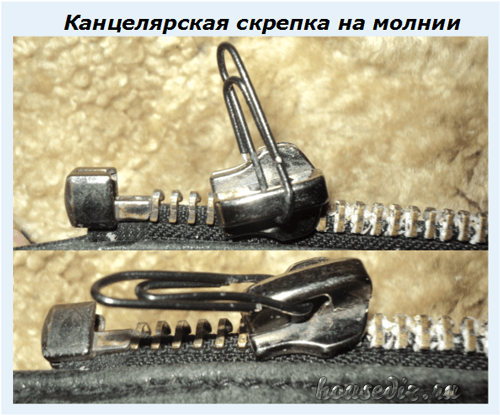
Repair features
The zipper is the most vulnerable part in any piece. It is subjected to constant mechanical stress, which leads to rapid wear. Replacing a zipper requires some experience. In some cases, for example, in shoes, this can only be done by a professional using special equipment.
Jacket
You can repair your jacket yourself if you have a sewing machine. First you need to remove the old zipper. At the same time, the finishing and connecting seam is unpicked. A leather jacket has a tape glued: it must be torn off. In a fabric jacket, a new fastener is inserted in place of the broken one and tacked to the lining. Fasten the zipper, check its work. The seam is sewn on a typewriter. The upper part is stitched, stitched along the old seam.
In a leather jacket, a new zipper is first glued on both sides. After drying, the correct installation of the zipper is determined. The zipper is sewn in with one seam, with the capture of 3 layers: trim, leather, wrong side. The threads are strong, elastic (not fishing line).
A bag
If a leather bag is not fastened, then it is better to send it for repair. Inexpensive bags can be repaired by hand. Twisted zippers are installed on them, which are easy to replace.
Backpack
To change a failed lightning, it is removed. The new fastener is straightened in unbuttoned form, sewn on. If the zipper has parted on one side, then the fabric is paired, where the lower part of the braid is sewn. Put the tape into the slider and check the adhesion of the teeth.

When the zipper diverges again, the slider is removed and its edges are squeezed with pliers. Tapes with teeth are inserted into it. Fasten the lower part of the zipper with threads, sew on the traces of the old line.
Jeans
In jeans, a metal zipper is installed on the fly. Sewing a new fastener yourself can ruin the thing. The repair consists in adjusting the sides of the slider to eliminate the discrepancy of the teeth.
Secrets of lightning care and breakage prevention
Always try to open and close the lock slowly and carefully.
It is especially important to explain to children that lightning does not tolerate sudden jerks and the use of brute force. Align the edges of the buckle before fastening
On some products, the zipper may bulge - it is advisable to try to flatten it and tighten it. If the fastener becomes very tight, it makes sense to lubricate it. Use bar soap or a wax candle to do this - just rub the prongs on each side and enjoy the ease of opening.
Shoe zippers should be regularly cleaned with a small brush. Fasteners of this type are especially afraid of the ingress of dirt and sand. Zippers on clothes have completely different "weaknesses". Before washing, they must be fastened and the product must be turned inside out. When ironing, try not to touch the clasp with the iron. By following these simple rules, you will most likely never run into problems. But if, nevertheless, the zipper on the bag broke, you now know how to fix it.
Solving the problem with lightning.
Today it is difficult to imagine how we could do without such a convenient and practical fastener - a zipper, which has become an integral part of many of our wardrobe items. Clothes, bags, footwear are far from the whole area of application of such a useful invention. But what if it breaks down? This is what we will try to understand further.
How to unfasten a zipper if it is open, what to do to keep the lock from opening: tips
Sometimes, on a zipper that has come apart, the slider gets stuck at the top or in the middle. What can be done in this case?
The technology depends on the type of zipper.
Detachable (used on sweaters, jackets or other outerwear):
- insert the bottom ends of the clasp into the square clip
- take the dog by its base, not by the decorative keychain
- pressing the slider to the links, smoothly and slowly, move it down
- hold the clasp with the other hand at all times
- when you reach the latch, gently hook it to the slider
- unzip
One-piece (sewn into jeans, skirts, trousers, bags, wallets):
- release the guides on top of the clasp
- slide the slider smoothly to the edge of the tape
- try not to get the fabric between the teeth and the dog
- remove the carriage from the zipper
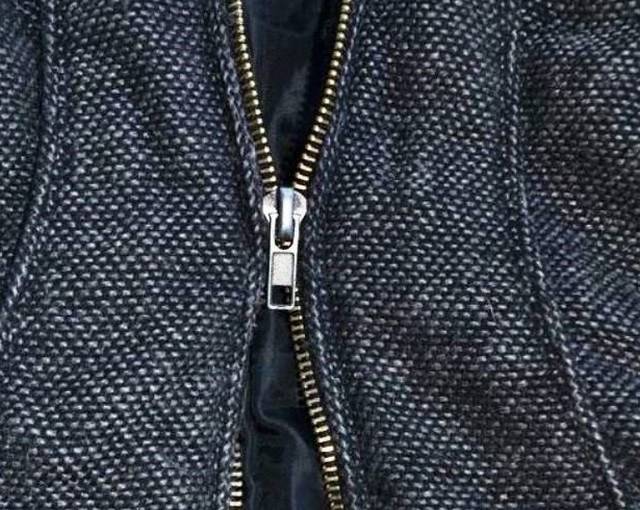
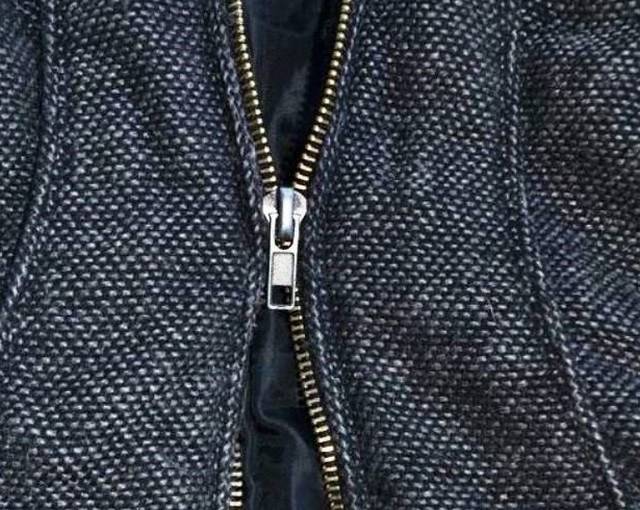
Now check if the fastener can be repaired. For this:
- hand connect the lower ends of the clasp
- grip the base of the slider with the other hand
- while holding the bottom end, slowly slide the "dog" up the zipper
- if, during this action, the links of the lightning did not connect, it must be replaced
In that case, when the adhesion between the links of the fastener does occur, there is a chance to repair the zipper yourself. It so happens that the lightning diverges from above. This problem occurs especially often with jeans or skirts.
In case of emergency, this method can help:
- thread an elastic band or wire ring into the dog
- fasten the "snake"
- put an elastic band (ring) on the button
- put the button through the loop
In order for the zipper to serve you for a long time and not break, use it correctly:
- do not pull the "dog" with all force and do not pull it back when fastening / unbuttoning
- before fastening the zipper, straighten the sides of the product so that there are no tight areas
- in cases where the lock is too tight, lubricate it with a suitable product or rub the teeth with a graphite pencil
- avoid excessive pressure on the clasp (buy clothes that are not too tight, do not carry a lot of things in your bag)
- periodically clean the fastener from dirt with a brush
- always zip up before washing and turn garment inside out
- fold things so that the zipper does not bend
- while ironing clothes, avoid touching the clasp with a hot iron
How to quickly fix a plastic zipper if it breaks or the slider has fallen off?
Manufacturers most often use a zipper made of plastic, which is sometimes called "tractor", for their products. It is not as strong as metal, however, it has a number of advantages in comparison with it:
- does not cling
- easier to fasten
- weighs less
- has a variety of colors
However, the disadvantages of the plastic fastener are that it breaks faster and the slider often “flies off” from it.
When the plastic zipper has just started to open, do the following:
- unfasten the clasp
- treat the cloves with a cotton swab dipped in an alcohol solution of rosin
- let dry for several hours
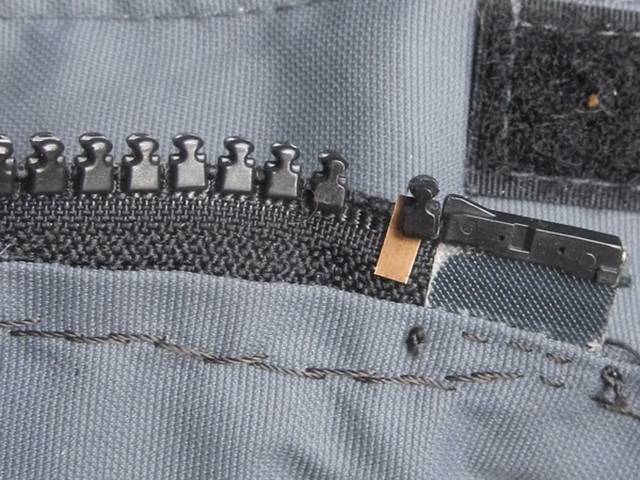
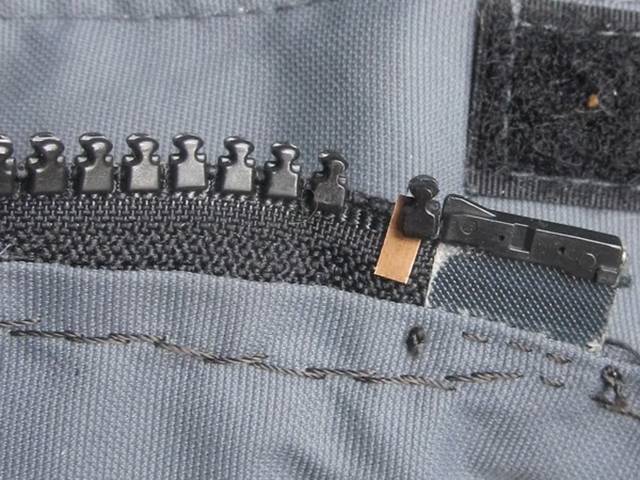
If this method did not help to correct the situation, then the slider is most likely damaged. It is unlikely that it will be possible to press it with pliers, since the plastic can simply burst. Therefore, the best way out is to replace the "doggie". This is done in the same way as in the case of a metal zipper, taking into account some points:
- locks that are removed from the clasp to replace the "dog", just glue in the same place
- in cases where this cannot be done, make a few stitches in place of the limiters with threads that match the color, which will hold the slider
- if the base is damaged with a one-piece zipper, grease this place with colorless varnish and let it dry completely
- in the case when several teeth have fallen out on the nylon "snake" or they are badly damaged, sew this section with a fishing line, winding the turns
- it is usually not possible to insert a "dog" into thin nylon zippers, since it is too small. Therefore, clothes with such locks are best taken to the atelier, where you can easily replace the fastener with a new one.
In emergency cases, when there is no possibility of buying a new slider, and there is nothing to replace the thing on which the fastener has come apart, you can try the following:
- use a lighter to warm up the slider
- under the influence of heat, its walls will become slightly softer
- squeeze the edges of the slider tightly
However, it must be said that this method is not very reliable due to the risk of damaging the fabric of the thing or the zipper itself.
How to extend the life of a zipper
In order for a clasp with a lock to serve as long as possible, it is enough to adhere to simple rules:
- carefully use the dog, do not expose it to sudden loads;
- do not bend the zipper during storage;
- if the metal fastener diverges, then try to adjust the course of its lock with pliers or a hammer;
- do not allow contact of the fastener made of plastic when ironing the linen with a hot iron;
- fasten the lock for the period of washing the linen until it touches the stopper;
- use wax or pencil lead as a preventative lubricant in the early stages of wear on the buckle lock.
Source:.
Types of lightning
Fasteners are classified according to the method of separation: full or partial. The use of this or that type depends on the functional purpose of the thing.
Unilateral
Detachable models are one-sided views. When unfastened, the fastener diverges in 2 sides, the slider remains on one of the halves. The design feature of split zippers is the presence of a pin and a split stop with a socket. The connection is made using a pin that goes through the holes of the slider and is fixed in the stopper. When disconnected, the pin remains on one half of the tape, the slider on the other. Single-slot views can have 1 or 2 locks. Two-way zippers have a more massive stopper and a long pin. Such fasteners are used on outer, sportswear.
Double-sided
On double-sided fasteners, the pawl always connects both halves: in the buttoned and unbuttoned position, which is typical for one-piece models with one or two locks. Such zippers are used on shoes, bags, clothes (trousers, skirts, dresses). The clasps have free webbing edges. In the lower part - the end point of unbuttoning, they are connected by one common stopper. At the top - the end point of the fastening - two (for each half of the zipper).
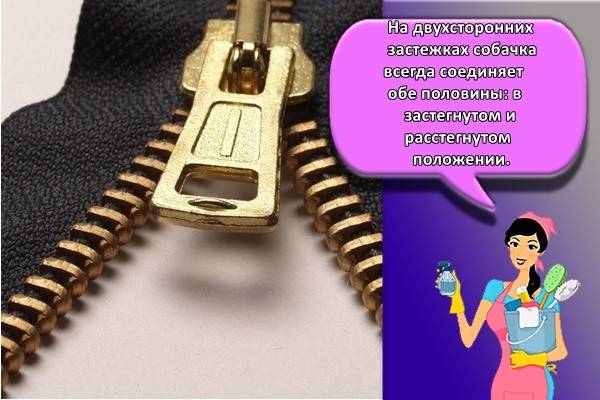
This type includes a double-sided, detachable zipper with two locks, in which the unfastening occurs not to the edges, but to the middle or from the middle to the edges. Two sliders act as a stop in the central part of the fastener.
How to fix an insert pin
The most effective way to fix a lock on a jacket is to give it to a tailor shop. Professional craftsmen will replace the mechanism and the product will not lose its original appearance. This will take time and money to pay for the work.

If the jacket is urgently needed, you can do it yourself to fix the zipper. This will require a cocktail tube and glue.
Step-by-step instructions for fixing the lock:
- Inspect the place where the pin is attached at the base. If the sealing tape comes off, and the fabric is tousled, then the place is treated with glue or nail polish. The frayed edges are carefully trimmed with scissors.
-
A 1 cm piece is cut from the cocktail tube. The ring is cut lengthwise and unfolded and bent in half.
-
The end of the zipper, where the plug-in pin used to be, is coated with glue on both sides. A piece of a plastic tube is glued to the fabric, pressed with a load until the glue dries.
- After drying, cut off the remnants.
-
The place where the plastic pin is glued is stitched. This will provide additional reliability and extend the service life.
The result is a tight pin that fits easily into the slider and split stop slot. If the color of the plastic is very different from the background of the jacket, it is painted with nail polish.
Important! Self-repair is a temporary measure.Plastic quickly deteriorates and stands out strongly
After the end of the season, the jacket should be taken to the atelier and a complete renovation carried out.
You can learn more about the repair process in the video:
Problem 2 - replacing the zipper slider
However, sometimes, even after such a procedure, the runner does not cope with its duties and does not pinch the teeth. In this case, it becomes necessary to replace it. This can be done in several ways.
Method 1
There is often a stopper at the top of the zipper, thanks to which the slider does not slide off when fastening. However, when you need to put a new slider, this lock becomes an obstacle. How to get rid of it? Take a screwdriver or any flat object and slightly pry open the stopper. You can use wire cutters. Remove it from the zipper. After installing the new slider, replace the retainer and tighten it firmly with pliers.
Method 2
The plastic zipper also has restraints. However, unlike metal ones, they are disposable: if you removed them from there, you won't be able to put them back. How to replace the slider in such a situation. Take a pair of pliers or scissors and simply remove the stopper from the garment. After replacing the slider, you need to make sure that this place protrudes above the teeth so that it cannot slip. This can be done with a thread. Take the thread and needle and sew a few stitches where the stopper was. You can also install a metal stopper if you have other items left over.
Method 3
Sometimes there is no stopper on the zipper, and the slider does not slide off the fastener due to the fact that its ends are sewn into the product. How to be in this case? There is only one way out. Take a ripper or small scissors and rip apart the hem of the garment. Remove the slider from the zipper and replace it with a new one. Then arm yourself with a needle and thread of a suitable color and sew up the ripped part.
The zipper does not fit well
This is not such a rare occurrence. The "dog" slips with difficulty on the lock, and additional difficulties arise with the fastening-unbuttoning. How to fix the lock on the jacket in this case?
There are several ways to debug a zipper:
- Lubricate the lock with lard along its entire length. This repair method is suitable for leather goods. If the item is made of textiles, greasy stains may appear on it.
- Candle wax. The wax-oiled fastener starts working normally.
- Lead of a soft pencil. The use of graphite to lubricate the snake, as practice shows, is the most effective.
Video
Surely many of you broke the lock - lightning. Zipper is a popular fastener, especially a detachable zipper, convenient, but alas, it sometimes breaks. And it is precisely the part that is located below that breaks down and is inserted into the counterpart, where it is fixed. What to do if you don’t want to change the lock, yes, sometimes, it’s not so easy (it can be very inconvenient to sew it on), but you want to wear a jacket with a zipper. This happens especially often with children's jackets and sweaters. Children are pulling lightning, in a hurry - and so they tear the mechanism. In order not to throw away practically new children's clothes, parents simply sew up the lower part of the lock and they have to put on the jacket first over the head, like a sweater, and only then zip it up. But this is not only inconvenient but also not very beautiful ... You cannot let a child go to school in such a jacket, especially when he is already a teenager.
So, you don’t want to sew up the lock at the base and don’t want (or are not able to) replace it. Well ... Then we fix it.
To begin with, we need a piece of iron from which we will make the part we need. We also need superglue and a paper clip. Superglue - one that hardens very quickly and becomes "like glass", very hard (based on cyacrolate, sold in small tubes of 1-2 grams).
So, we remove all unnecessary, after soaking the fabric with superglue.It will grab quickly and stiffen. Cut carefully with pliers. (photo 1).
Now it's up to the main part. We cut it to size from a piece of stainless steel or tinned tin (you can take it from a can of condensed milk) and fold it as shown in photo 2.
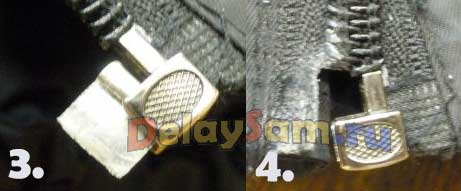
It should fit well into the part of the castle that moves and be well fixed in the part that is below (photo 3). Next, we manage to fasten the lock (photo 4). This can be done by hand connecting each clove in series. Surely, everyone did this when they tried to understand how this thing works or when the lightning "parted" in the middle.

After that, we put our piece of iron on the inside of the lock and put it on superglue (photos 5 and 6). Trying to unbutton. If you did everything well, then the lock should unfasten, although at first - until the piece of iron is rubbed in, you can do it with some effort. Take your time, because the glue may not have time to set completely. So, you unbuttoned the lock. Everything works, but this is not enough.
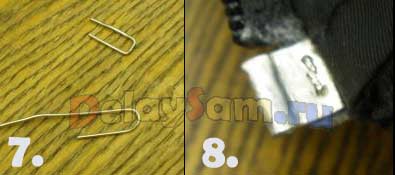
Now we need to strengthen our construction. We drill 2 small holes and insert a bracket made from an ordinary paper clip (photo 7, 8,).
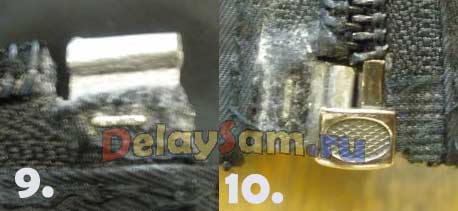
Now that's it (photo 9, 10).
We finally check the work of our zipper. For a better look, you can touch up the glued areas with a permanent marker. For good work, I recommend rubbing the lock with paraffin or stearin (with an ordinary candle) or just soap.
Some Useful Tips on Zippers
If the lock is taut with a zipper, rub it with a stearic candle. This advice is especially effective for metal zippers. The lead of a soft pencil will also help. It is enough to swipe them through the lightning several times.
If the zipper often spontaneously diverges in the middle, lightly tap on the lock (its edges, and not on the bracket for which the tongue is attached) with a small hammer.
Tapping the lightning itself, if it is metal, will also help.
The lock will begin to move tighter, but the lightning will stop diverging.
If the tab comes off on the zip lock, you can replace it with a regular paper clip.
If the zipper on your trousers tends to unfasten itself, thread a small key ring into its tongue and tie it over the button of your trouser belt. Such a ring can also be made from a paper clip.
Zippers on shoes suffer greatly from dampness, wet and salty snow, slush. Which drastically shortens their service life. Run a piece of unsalted lard over them, or use a special hydrophobic lubricant often. And the zipper will be protected from dampness. This lubricant will also improve its performance.
So, the zipper is stuck and does not go down, and you are caught by your thing, because in order to take it off, you need to open the zipper.
Take a regular pencil with a graphite rod and rub the zipper teeth with it. This should help. If not, you need to increase the glide, such as rubbing the teeth with soap, lip balm, or detergent that reduces friction.
Using a cotton swab, apply the lubricant to the zipper and teeth. Then pull the fastener down, repeat the lubrication procedure again. Continue until the clasp is completely open.
How to fix a zipper
Of course, there are different situations. Sometimes the zipper just crumbles to pieces from long use, and sometimes a brand new zipper tears like rags. Then there can be no question of any repairs. But more often than not, a zipper can be repaired quickly. So, let's look at the most typical cases.
Lightning starts to disperse
If this happens, then there is no need to rush to change it. First, you should try to lightly knock on it from the inside and outside with a hammer, and you will have to walk along the entire length three times
Then you will need to reduce the gaps between the top and bottom of the runner, for which you will need to carefully squeeze it with ordinary pliers.But such resuscitation can be carried out only once, the castle will no longer withstand and will fall apart completely.
Therefore, if you managed to save your lightning once, then try to prepare a spare slider - just in case of fire.

If the lightning breaks, you can try fixing it at home. Further step by step photo instructions
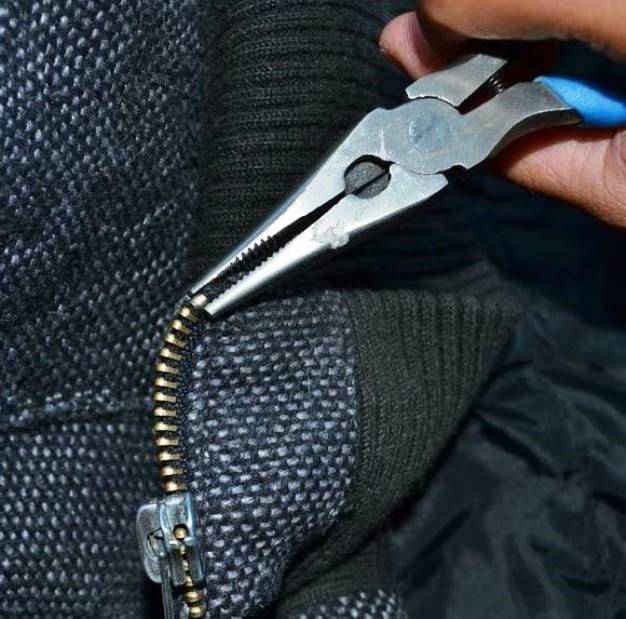

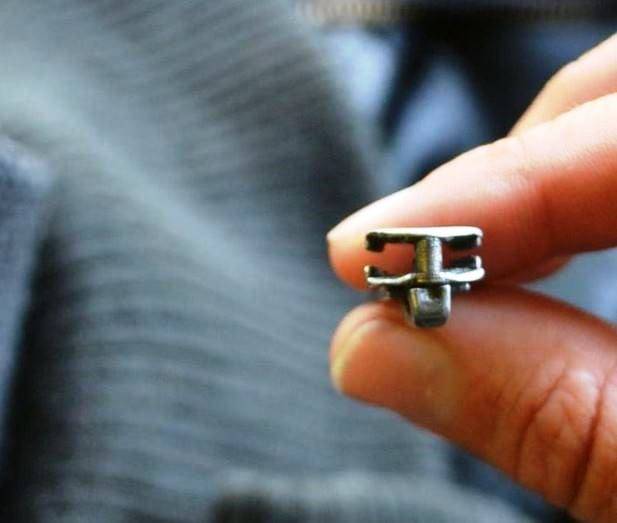

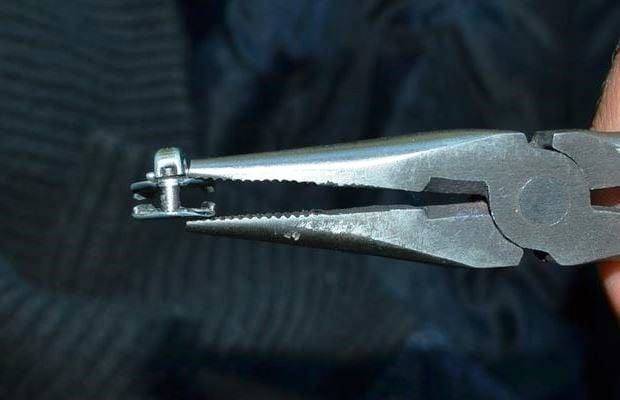

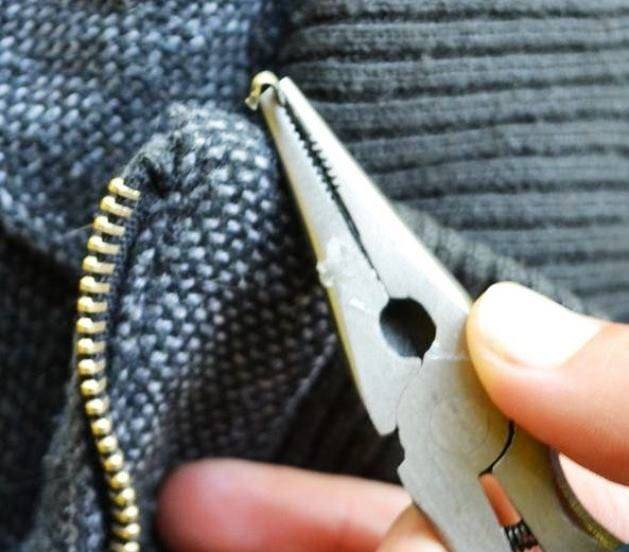

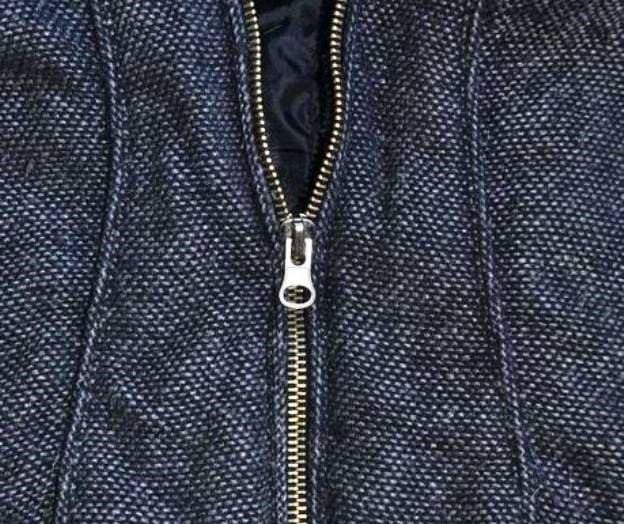
If the lightning strikes periodically
If the lightning diverges periodically, and this happens not for the first time, then you will have to change the slider ("dog"). To remove the old slider, you need to remove the stopper (small plate) located at the bottom or top of the zipper.
The teeth fell out
When several teeth have fallen out of the nylon zipper, you can also try to restore them using a bandage: the damaged area is stitched with a fishing line, loop by loop.
If the zipper comes off the base
If the clasp is prompted by the Internet resource. And a zipper torn off from the base (fabric) can be sewn using a machine needle. This method is especially convenient for work on the implementation of repairs in the most inaccessible areas, for example, in boots, since the puncture is carried out only in one direction.
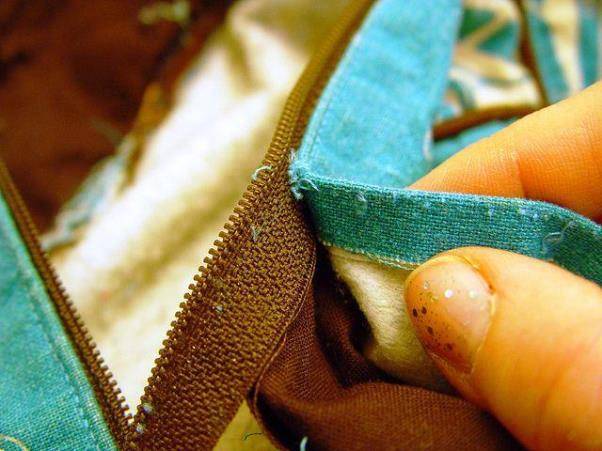
It is better to sew the torn off zipper with a typewriter
If you need to fix a metal zipper
If it is not a nylon lightning, but a metal lightning that is dispersed, then it must also be carefully forged on both sides, but with heavier blows of a hammer, and then the gap between the lower and upper halves of the lock should be reduced.
If the plastic zipper breaks
The plastic zipper that begins to separate on the shoe can be refurbished. Its performance will be restored if you unfasten the lock and moisten its cloves with an alcoholic solution of rosin (a flux used for soldering). Then you need to let the lightning dry for several hours. This will make the fastener work more reliably, but this operation will have to be repeated over time.
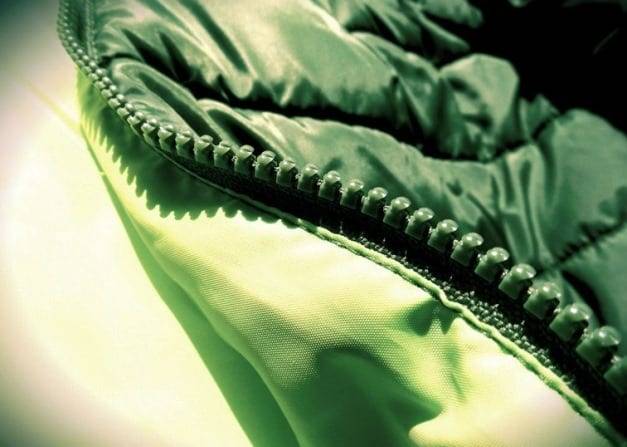
Plastic zippers require more gentle handling than metal ones

